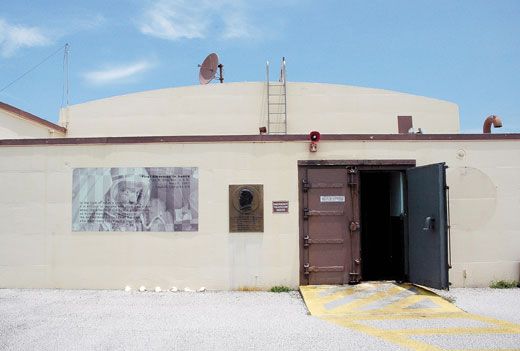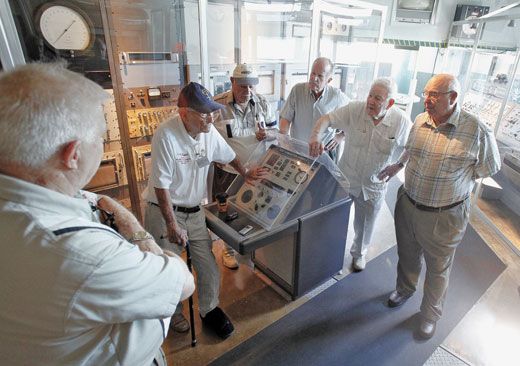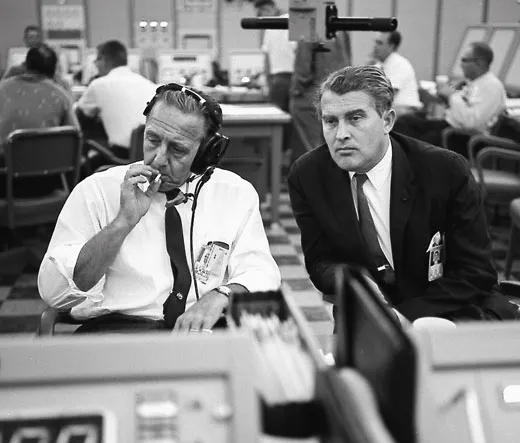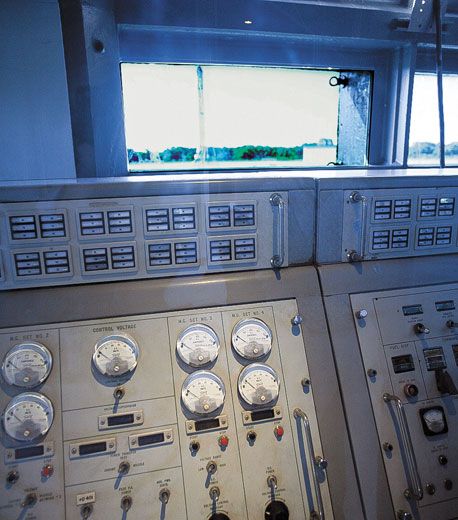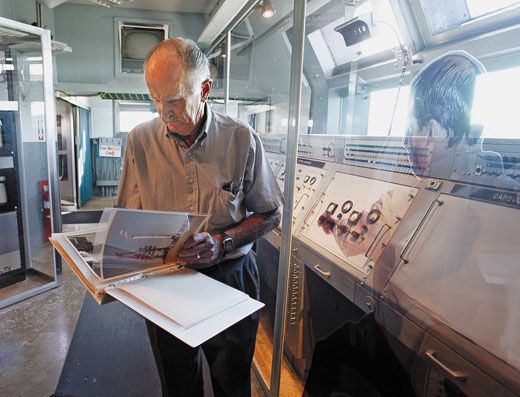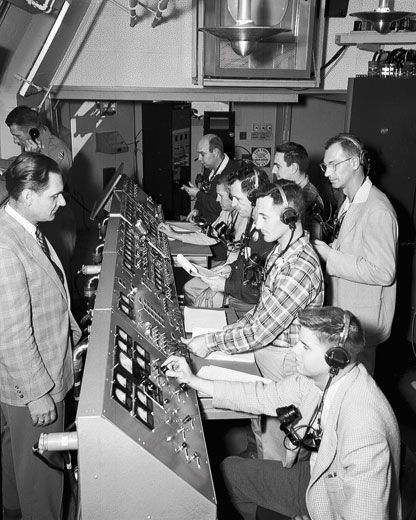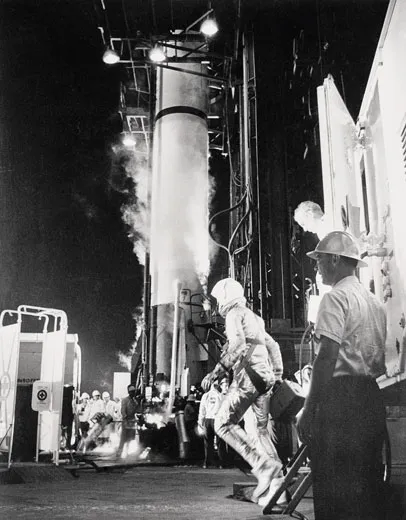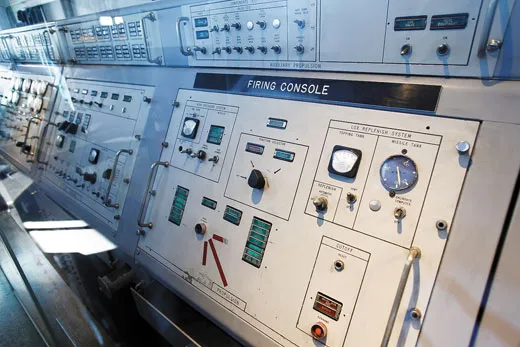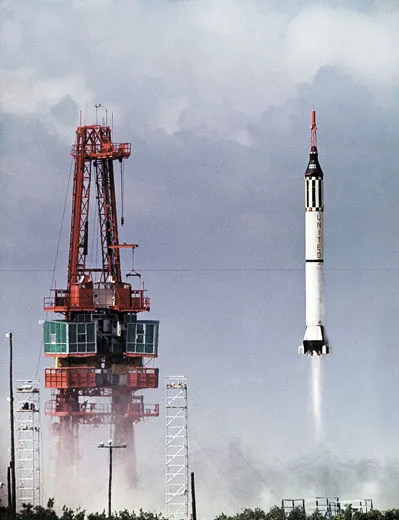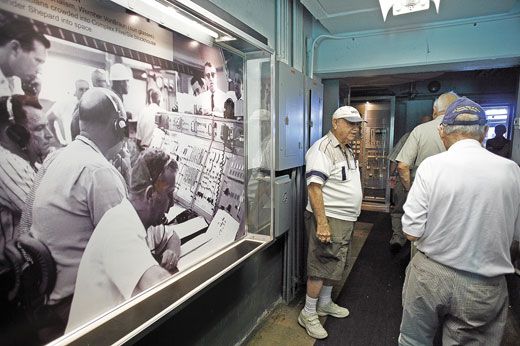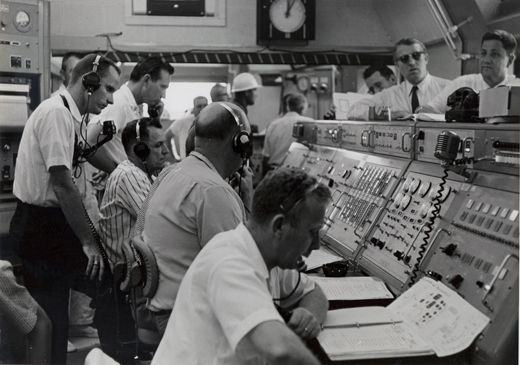Light This Candle
Alan Shepard was brave enough to ride the Mercury-Redstone rocket. These guys were brave enough to launch it.
/https://tf-cmsv2-smithsonianmag-media.s3.amazonaws.com/filer/Candle-Lighters-Veterans-FLASH.jpg)
The door to the Redstone blockhouse at Cape Canaveral’s Launch Complex 5/6 is made of half-foot-thick steel, so it takes some strength to pull open. The walls are reinforced concrete. The narrow windows—slots, really—are multiple panes of bulletproof glass. Just outside, a short walk away, is the launch pad, where a slender, eight-story rocket stands with a Mercury capsule perched on top—a close match to the one that Alan Shepard rode to become the first American launched into space.
On a sunny day last September, 50 years and a few months after Shepard’s May 5, 1961 flight, eight men, most in their 80s, pile out of a van and enter the dark, seldom-visited bunker, now a stop on a NASA tour. At first glance it could be a bunch of retirees on vacation. But these guys don’t need a tour guide. They used to work here. I’ve come along to hear them reminisce about a time when they and their co-workers sent the first astronauts into space.
Inside, still adjusting our eyes from the Florida sunshine, we stop at a blowup of an old black-and-white photo on the wall. “Look at that,” says Ike Rigell, pointing his cane at the figures seated at a launch console. Three of the men in the picture are in our party. “That’s me. That’s you, Curly.” Wernher von Braun is in the picture too. According to the caption, it was taken shortly before Shepard’s launch.
In the photo, the young men appear to be studying a list of procedures. “We didn’t usually do that,” says Rigell. “We weren’t very paper-oriented.” Everybody laughs.
We move farther into the blockhouse, which has the original consoles, with dials and old-fashioned gauges, preserved behind plexiglass. “Primitive,” somebody mutters. “They’ve done a lot of rearranging,” says Rigell, looking around.
“What kinds of computers did you have in here?” I ask. More laughter. “Did we have computers?” One of the men points to the bank of gray consoles. “Milt, you stood there. Frank, you were over there.”
And they start to reminisce.
IN NOVEMBER 1960, John F. Kennedy was a newly elected president, Elvis’ “It’s Now or Never” was on the radio, and America was in a race with the Soviet Union to launch the first person into space. Reaching orbit would require a modified Atlas, the nation’s first intercontinental ballistic missile, which had been in service for only a year. First, though, NASA wanted to test its new Mercury capsule, with an astronaut inside, which a smaller rocket, a Redstone, would loft to an altitude of just over 100 miles. The flight would last only 15 minutes, and the capsule would splash down in the ocean near the Bahamas.
The Redstone was a battlefield missile with a 200-mile range, about the same as that of the Iraqi Scuds made famous a generation later in the first Gulf War. Standing 83 feet tall and weighing just six tons without fuel, the Redstone and its more powerful variants—Jupiter and Juno—were direct descendants of the V-2 weapons Germany developed during World War II. They were even built by the same people—Wernher von Braun and his band of German rocket engineers, who had surrendered to the Americans at war’s end and now worked for the U.S. Army as its Space Age artillery unit.
Among the expatriates were Kurt Debus, Hans Gruene, and Albert Zeiler, all of whom had been with von Braun since the early 1940s, when they launched V-2s from the Baltic coast site of Peenemünde. In 1950, the German rocket team moved from Fort Bliss, Texas, to the Army’s Redstone Arsenal in Huntsville, Alabama, where they immediately began hiring young American engineers to help build and launch ballistic missiles.
William “Curly” Chandler was raised not far from Huntsville, and at the time was working in Chattanooga for the Tennessee Valley Authority—just the kind of large technical organization von Braun targeted for recruiting. Chandler went for an interview one weekend while visiting home, got the job, and talked it up to his buddy Ike Rigell, another Alabama native, who had fought with the Marines at Saipan and Iwo Jima. In 1951, Rigell was 28 and had recently graduated from the Georgia Institute of Technology with an electrical engineering degree, courtesy of the GI bill. He and Chandler were among the first hires for von Braun’s Huntsville operation. Both ended up working on every Redstone launch, starting with the first, in 1953.
Soon thereafter, others in our group of Mercury-Redstone veterans arrived in Huntsville. Terry Greenfield started at Redstone’s fabrication laboratory, the “Fab Lab,” in 1955, when he was still in the Army, and stayed on after he was discharged. John Twigg arrived in the spring of 1956, a GI with an engineering degree from Johns Hopkins. Frank Bryan, with a physics degree from the University of Texas, started in Huntsville in 1957, the year the Soviets launched Sputnik, the world’s first artificial satellite.
Von Braun had been lobbying to do that very thing since 1954, but had been held back, in part because the Eisenhower administration worried that launching the country’s first scientific satellite on a weapon would have bad PR fallout. Before the Mercury program came along, space was still a sideline for the Huntsville team. Their main business was building, testing, and deploying short-range Redstone missiles and intermediate-range Jupiters to Army units in Germany and U.S. and NATO troops in Turkey and Italy. (The Turkish Jupiters would become a bargaining chip in the 1962 Cuban Missile Crisis.)
Although the Redstone was designed and built in Huntsville, the Army’s firing range was in Florida. Based at Cape Canaveral, the group of seasoned rocketeers, working at what was then called the Missile Firing Laboratory, numbered about 500 by the time of the first unmanned Mercury launch, in 1960.
Their boss was Kurt Debus, a Peenemünde veteran with a fencing scar on his cheek from his student days at the Technical University in Darmstadt. Frank Bryan remembers Debus always wearing a black hard hat around the launch pad. Bryan and the other Mercury-Redstone veterans recall the Germans with great respect. They speak of their bosses’ team spirit, their fairness, their engineering smarts. “The best thing we ever did was get the Germans over here after the war,” says Rigell.
One policy they admired was Debus’ practice of not punishing people for mistakes—if they admitted them. “We got rid of a lot of our problems, what we called phantoms, by owning up to mistakes,” says Chandler. He recalls one time when a rocket on the pad suddenly lost power, then just as suddenly got it back. “We had a janitor who was cleaning the trenches out where the cables were. He had disconnected one cable, then quickly reconnected it. We would have ended up replacing all the cables if that janitor hadn’t told us what he had done. He was working for a contractor, and they were going to fire him. But Dr. Debus told them not to.”
Team members trusted one another, and each man knew his system down to the last wire. There were no consultants or technical contractors. “Those cables that go over to the rocket? We put ’em in,” says Rigell. “If you opened the black box, we did it.” Later on, as the rockets became bigger and more complex (and many in this group went on to work on the Apollo program’s Saturn V), the procedures would become more formal and documented. But in the Redstone days, says Greenfield, “it was people, not paper.” On launch day, “nobody had a call sign. It was just your name: ‘Curly, is the inverter okay?’ ”
Not that there weren’t failures, or, as Chandler prefers to think of them, “learning experiences.” There was the time in 1954, on the third Redstone launch, that the rocket exploded at liftoff, blowing debris through a cable trench back into the blockhouse. In July 1959, a Juno went up for five seconds, did a U-turn, and came down in a fireball not far from the blockhouse, where TV journalist Edward R. Murrow was inside, cameras rolling, filming a segment for his new show, “CBS Reports.”
Maybe it was the explosions that inured the team to the dangers of their business. Standing next to the Redstone at Launch Complex 5 last September, some of the veterans recalled how casually they behaved around fueled rockets. “We used to walk out here when there was oxygen flowing all over the pad, and your clothes would get saturated with it, which was very dangerous in itself,” says Tom Allen, who worked on the Redstone’s program control device. “We didn’t ever think about that.” Chandler nods: “I think God protected us, I really do. We did a lot of things that were very, very unsafe—putting ladders up against the vehicle, getting ground static—a lot of things could have happened. All you needed was a spark.”
Frank Bryan recalls one time when he was on the launch pad, watching liquid oxygen vapor swirl around in little balls near the base of the rocket. “Somebody had told me you could stomp on those things and make them pop. I was doing that, stomping on these little balls of LOX. Albert Zeiler [a senior German, who headed mechanical and propulsion engineering for the Redstone] came up and said, ‘You stupid kid, you’re going to blow your foot off.’ ”
By the time of Shepard’s launch, the Redstone had made 69 flights with an 81 percent success rate—good enough in those days to earn it the nickname “Old Reliable.” In 1958, three months after the Sputnik launch, von Braun’s team had boosted national pride with the launch of America’s first satellite, Explorer 1, on a Juno 1. Now, with Mercury-Redstone, that team would be asked to demonstrate that an astronaut could survive a launch into space.
In 1960, the Huntsville missile group became part of NASA, and got a new name: the Marshall Space Flight Center. The Mercury capsule, meanwhile, was being developed at the agency’s Langley Research Center in Virginia, by the Space Task Group, headed by Robert Gilruth.
The Redstone and Mercury teams cooperated closely, and got along fine at a personal level. But there was an unspoken rivalry too. “The Redstone guys generally had an attitude that ‘We know what we’re doing, and it’s our launch pad,’ ” says Bryan. “The guys working on the [Mercury] capsule, from STG and McDonnell [the capsule contractor], had a lot of delays, indicating that things were new for them. Which you could understand. But our guys would double-check anything they told us, just to make sure.”
Converting a missile launcher to an astronaut-friendly rocket required about 800 modifications to the Redstone, but none was especially daunting. Some were even a step backward in terms of complexity. Instead of the highly toxic Hydyne they’d been using as fuel for longer-range Jupiters and Junos, the team switched back to alcohol, which was safer. And they used a simpler (thus less breakdown-prone) guidance control system that dated back to the V-2 days. The Redstone’s fuel tank was stretched to increase the flight time by about 20 seconds, but that too was pretty straightforward.
One key modification was adding sensors that could signal trouble and trigger an abort if some key parameter, like fuel tank pressure, was out of whack. The biggest change: placing a rocket-propelled escape tower on top of the Redstone that would pull the Mercury capsule and astronaut to safety if something went wrong early in the flight.
By November 21, 1960, the first Mercury-Redstone, MR-1, was ready for a test launch, with an empty capsule on top. The engine roared, the rocket started to rise…. then immediately settled back onto the pad. (MR-1 is still remembered as “the four-inch flight.”) With the entire space press corps watching, the escape tower blasted upward, and moments later the parachute and recovery gear came dribbling out the capsule.
In the blockhouse, the launch team was speechless. Nothing like this had ever happened. Now there was a live rocket sitting out there with 27 tons of explosive fuel. Unable to leave the blockhouse, the team considered their options. At one point, Zeiler proposed having someone shoot holes in the oxygen tank with a rifle to relieve pressure. Debus nixed the idea. Eventually they sent someone out to open up the tail of the rocket, attach a line, and slowly vent the pressure through one of the valves.
Later, they figured out what had happened. Before launch, a pad technician had been struggling to make one of the rocket’s electrical plugs fit, and had shaved off part of it. The result, on launch day, was an unintended “sneak circuit” from the ground to the rocket, milliseconds after ignition, that caused the engine to shut down. The team immediately modified the hardware to prevent another sneak circuit, and in typical Debus management style, the technician who admitted his mistake got a commendation.
A month later, MR-1A went off without a hitch. That was followed on January 31 by MR-2, with a chimpanzee named Ham inside the capsule. He was recovered safely after an ocean splashdown, but the vehicle had over-accelerated, and Debus wanted one more flawless test before putting an astronaut on board. His caution cost Shepard the honor of being the first man in space. Yuri Gagarin launched from the Soviet Union on April 12, just 19 days after the added Redstone test. The STG Mercury team, including Shepard, were angry; despite the problems on MR-2, they had wanted to go ahead with a manned flight.
The blockhouse crew generally stuck to engineering issues and left the politics and public relations to their bosses. But the pressure to succeed on the first manned launch was overwhelming, Rigell says. “To me, this launch had to go right, or we would have been…I can’t think of how low we would have been. To me, there was a tremendous amount riding on this thing.”
By the first week of May 1961, they were ready. The known problems had been solved and all systems triple-checked. “I felt comfortable,” says Greenfield, looking back. “I would have flown on that Redstone.”
The silver-suited astronaut rode to the pad in the pre-dawn hours of Friday, May 5, 1961. He had been through this suspense three days earlier, when the launch had to be scrubbed due to weather. On that morning the First Astronaut’s identity was a mystery to the American public. But for this second try, NASA decided to reveal that it was 37-year-old Navy Commander Alan Shepard.
Recalling the scene 50 years later, the Mercury-Redstone veterans, all of whom were on duty that morning, remember that they and their colleagues would drift in and out of the blockhouse, depending on what was happening in the countdown. Rigell still has a chart showing all the people who worked on the MR-3 launch. It lists 68 names, but there were at least 75 in the blockhouse, including observers like von Braun. Most of the people in the back rooms were from the STG and McDonnell, including astronaut Gordon Cooper, who in the hours before launch was communicating with Shepard along with other STG team members.
Standing at the narrow window, looking out at the rocket, were Peenemünde veterans von Braun, Debus, and Zeiler. It was Zeiler who, at the critical moment of liftoff, would intently watch the color and shape of the exhaust flame, his finger on an abort button, which could instantly shut down the engines if he saw something amiss.
As usual, the launch was preceded by holds in the countdown. Nothing memorable for the missile firing team, but for Shepard, alone in the tiny Mercury capsule, anticipating a ride that no American had ever experienced, it was intense. In the last two hours of the count there were six holds, including one to evaluate the weather and switch out a power supply, and another to check computer synching between the Goddard Space Flight Center in Maryland and the Mercury Control Center.
Finally, at 9:34 a.m., with all the issues resolved, a firing command was sent that initiated a 35-second sequence of closing valves, pressurizing the tanks, and igniting the engine. Later, in a postflight press conference, a reporter asked Debus who pushed the button. “I’ve said many times there is no button [at the time of liftoff],” he answered impatiently. “It wouldn’t be proper to single out any one individual.” The guys in the blockhouse agree that no one button was more important than any other. But the person who sent the firing command on that day was Jack Humphrey.
You can read in the NASA histories what happened next: how Shepard’s 15-minute flight went flawlessly, and how it prompted a young president to commit the nation to a moon landing that many of the men in this room devoted their careers to—and today look back on with pride. But before we leave the blockhouse, I want to hear about another moment shortly before liftoff, when Shepard uttered one of the most famous lines in the history of space exploration. With less than three minutes left until launch, exasperated by yet another hold, he barked: “Why don’t you fix your little problem and light this candle!” In the film version of Tom Wolfe’s The Right Stuff, the scene is played as caricature: a brave astronaut scolding a bunch of fussy nerds in lab coats, one of whom has a comical German accent.
Here’s what really happened in the LC 5/6 blockhouse: The count was stopped because the propulsion regulator indicated a pressure increase. One of the members of the firing team, Andy Pickett, noted the reading and flicked a switch a couple of times to open and close a vent valve until the pressure returned to normal. The hold lasted only a minute. Not a big deal.
As for Shepard, nobody on the firing team even heard him—he wasn’t on their voice loop.
I ask the Redstone veterans: “If you had heard Shepard ordering you to ‘light this candle,’ would you have cared?”
Slight pause. Then Greenfield answers: “No.”
And everybody laughs.
